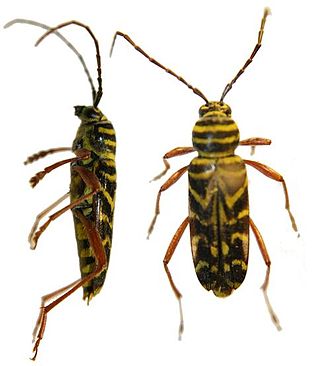
Desmocerus is a genus of beetles in the family Cerambycidae, containing the following species:

Grammoptera is a genus of beetles in the family Cerambycidae, distributed primarily in the Northern Hemisphere.
Mecometopus is a genus of beetles in the family Cerambycidae, containing the following species:

Megacyllene is a genus of beetles in the family Cerambycidae, containing the following species:

Neoclytus is a genus of beetles in the family Cerambycidae. They measure 4-20 mm. There are 93 species in the New World.
Trichoxys is a genus of beetles in the family Cerambycidae, containing the following species:
Gurubira is a genus of beetles in the family Cerambycidae, containing the following species:

Haenkea is a genus of beetles in the family Cerambycidae, containing the following species:

Ischionodonta is a genus of beetles in the family Cerambycidae, containing the following species:
Listroptera is a genus of beetles in the family Cerambycidae, containing the following species:

Rhopalophora is a genus of beetles in the family Cerambycidae, containing the following species:

Eriphus is a genus of beetles in the family Cerambycidae, containing the following species:
Triacetelus is a genus of beetles in the family Cerambycidae, containing the following species:
Domitia is a genus of Long-Horned Beetles in the beetle family Cerambycidae. There are about seven described species in Domitia, found in Sub-Saharan Africa.
Domitia aenea is a species of long-horned beetle in the family Cerambycidae. It is found in Ghana, Guinea, and Ivory Coast.
Domitia cervina is a species of flat-faced longhorns in the beetle family Cerambycidae. It is found in Angola, DR Congo, Gabon, Central African Republic, and Republic of the Congo.
Domitia lupanaria is a species of flat-faced longhorns in the beetle family Cerambycidae. It is found in Gabon.
Domitia marshalli is a species of flat-faced longhorns in the beetle family Cerambycidae. It is found in the Central African Republic, Republic of the Congo, Cameroon, and DR Congo.
Domitia basilewskyi is a species of flat-faced longhorns in the beetle family Cerambycidae. It is found in Rwanda.
Domitia bomansi is a species of flat-faced longhorns in the beetle family Cerambycidae. It is found in DR Congo.






